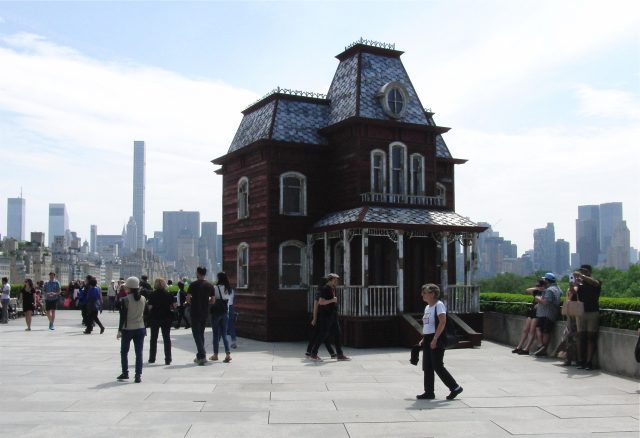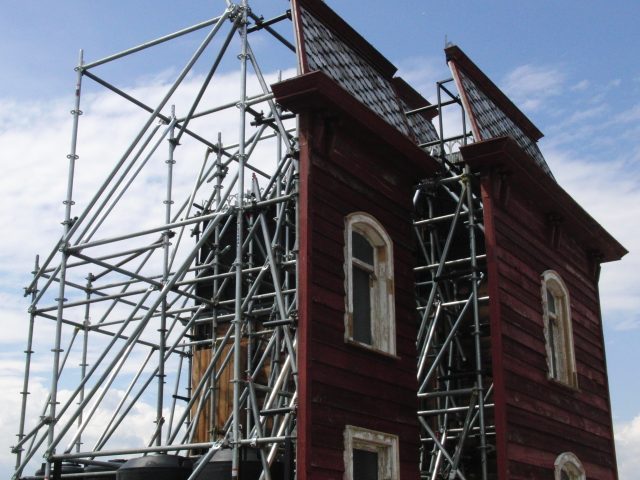
Cornelia Parker has added “Transitional Object (PsychoBarn)” to New York City skyline on Met roof (photo by twi-ny/mdr)
THE ROOF GARDEN COMMISSION
Metropolitan Museum of Art, Iris and B. Gerald Cantor Roof Garden
1000 Fifth Ave. at 82nd St.
Daily through October 31, recommended admission $12-$25
MetFridays: Friday, October 28, 6:30
212-535-7710
www.metmuseum.org
rooftop slideshow
Don’t let Halloween pass by without a visit to the Metropolitan Museum of Art. In her Guardian nomination for 2016 Visionary, British artist Cornelia Parker hinted at her upcoming Met Roof Garden commission, saying, “I always think of New York as Europe on steroids, so I’m celebrating American culture, but through European eyes. I’ll make something that adds to the view.” Her site-specific installation went up in April, and it will remain as a temporary addition to the view of the New York City skyline visible from the roof through, appropriately enough, Halloween. “Transitional Object (PsychoBarn)” is a multilayered construction that melds fiction with reality, a soothing work that is just the right amount of twisted. Using materials obtained from a dismantled Dutch red barn in Schoharie in Upstate New York, Parker has re-created the facade of the creepy Victorian house from Alfred Hitchcock’s Psycho, where Norman Bates (Anthony Perkins) lived with his mother. The Psycho house, which itself was just a facade on a Hollywood studio set, was inspired by Edward Hopper’s “House by the Railroad,” so Parker, who was raised on a farm in rural Cheshire, where there were black barns, is referencing American pop culture, art history, and her own personal story. She’s also combining a kind of good and evil duality; barn raisings, for example, are a joyous community event, while the Psycho house evokes gloom and doom, murder and madness.

Cornelia Parker opens back of installation to reveal inner psyche of structure (photo by twi-ny/mdr)
As if revealing the twenty-eight-foot-tall work’s inner psyche, Parker keeps the back open so visitors can see the scaffolding and heavy water tanks that keep the facade from collapsing, which relates to her new artist book, Verso, in which she explores the front and back of button holes. “Transitional Object” is named for the medical term for a security blanket, an item that brings children comfort as they grow up and spend less time with their mother — except maybe for Norman Bates, who created a rather unique transitional object for himself. The structure blends in well with the city skyline, which features many a building that just might be haunted, while also offering fun-house-style reflections in the Met’s mirrored wall by the rooftop bar. Parker, who has previously placed Tilda Swinton in a glass case at the Serpentine Gallery for “The Maybe” and blew up a garden shed for “Cold Dark Matter: An Exploded View,” will be at the Met on October 28 at 6:30 to talk about the project as part of the MetFridays presentation “Artists on Artworks — Cornelia Parker,” which is free with museum admission and is first-come, first-served; stickers will be handed out twenty minutes before the event. For more Halloween joy, MetLiveArts is screening the Peanuts holiday classic It’s the Great Pumpkin, Charlie Brown on October 29 at 11:00 am and 1:00 pm, with live music by Rob Schwimmer and his ensemble, followed by costume parades.